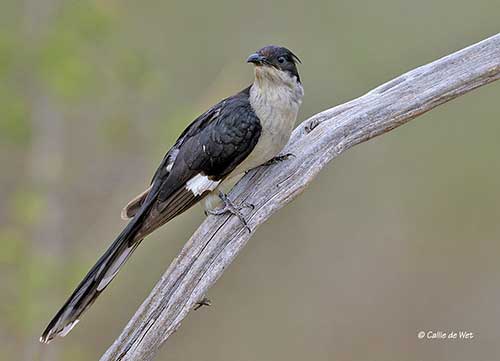
Fr : Coucou jacobin
Ang : Jacobin Cuckoo – Pied Cuckoo - Black and White Cuckoo
All : Jakobinerkuckuck
Esp : Críalo Blanquinegro
Ita : Cuculo bianco e nero
Nd : Jacobijnkoekoek
Sd : jakobinskatgök
Photographers:
Callie de Wet
GALLERY
Jean Marc Rabby
Des Ailes et des Plumes
Text by Nicole Bouglouan
Sources:
HANDBOOK OF THE BIRDS OF THE WORLD vol 4 by Josep del Hoyo-Andrew Elliott-Jordi Sargatal - Lynx Edicions - ISBN: 8487334229
BIRDS OF THE GAMBIA AND SENEGAL by Clive Barlow and Tim Wacher – Helm Field guides – ISBN: 0713675497
BIRDS OF AFRICA SOUTH OF THE SAHARA by Ian Sinclair and Peter Ryan - Princeton University Press Princeton and Oxford - ISBN: 0691118159
BIRDS OF EAST AFRICA vol 1 by C.A.W. Guggisberg – Mount Kenya Sundries Ltd. – ISBN: 9966889051
ROBERTS BIRDS OF SOUTH AFRICA by G. R. Mc Lachlan and R. Liversidge – The Trustees of the John Voelcker Bird Book Fund – ISBN: 0620031182
Biodiversity Explorer – The Web of Life in Southern Africa
Roberts Online – Birds of Southern Africa
Wikipedia, the free encyclopaedia
JUSTAVES…for the love of birds…
Jacobin Cuckoo
Clamator jacobinus
Cuculiformes Order – Cuculidae Family
INTRODUCTION:
The Jacobin Cuckoo is a member of the subfamily Cuculinae within the large family Cuculidae that includes the Old World brood-parasitic cuckoos. It is found in sub-Saharan Africa and in India, Sri Lanka and Myanmar. It is sometimes confused with the larger and heavier Levaillant’s Cuckoo.
The Jacobin Cuckoo frequents dry, thorny scrubs and open woodlands. It is a common intra-African migrant and also moves between India and Africa. Its movements are complex and probably associated with rains.
This species has three subspecies. The race C.j. serratus of South Africa has two morphs, a dark morph will all balck plumage, and a black-and-white morph with grey breast.
The Jacobin Cuckoo is not globally threatened and currently, the populations are stable.

DESCRIPTION OF THE BIRD:
Biometrics:
Length: 34-35 cm
Weight: 66 g (India) – 72 g (Africa)
The Jacobin Cuckoo adult of nominate race (not displayed) has glossy black or dark brown upperparts with a white wingbar visible on closed wings but more conspicuous in flight. The long, graduated tail is tipped white.
The underparts are white.
The head is black, but lower cheeks, chin and throat are white. We can see a pointed crest on the nape.
The bill is black. The eyes are dark brown. Legs and feet are grey.
Male and female are similar.
The juvenile is browner above and buffy-white below. It has reduced crest, and smaller white wingbar, but the tail is tipped white like in adults. The bill is black with yellow-orange gape. The eyes are dark brown.
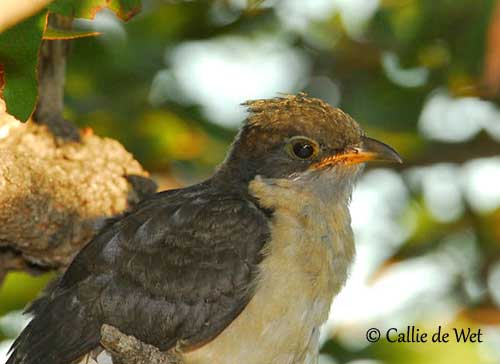
C.j. serratus
Juvenile
SUBSPECIES AND RANGE:
The Jacobin Cuckoo has three subspecies.
C.j. jacobinus (described above but not displayed) occurs in S India and Sri Lanka. It is smaller than other races.
C.j. pica (displayed) occurs in sub-Saharan Africa, S to Tanzania and Zambia, and NW India to Nepal and Myanmar, and occasionally in S Tibet, in foothills of Mt Everest. This race is larger than previous and unstreaked below.
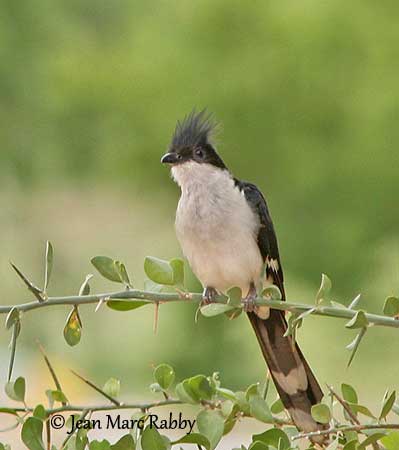
C.j. serratus (displayed) is found in S Africa (S from S Zambia). This one is larger and has two color morphs. The grey-breasted type (displayed) is greyish-white to white below. The throat shows blackish streaks.
The dark morph is mainly found in coastal South Africa. It is glossy black overall, including the tail (no white tips) but it has the white wing patch.
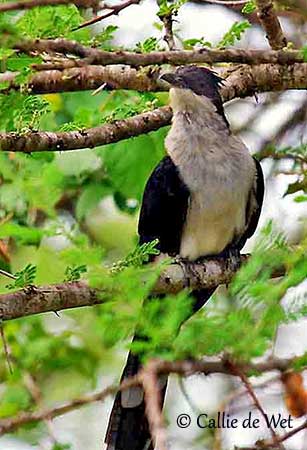
HABITAT:
The Jacobin Cuckoo frequents woodlands, thickets, dry, wooded savannas and grassy marsh habitats. In Indian range, it occurs mainly in lowland, plains and hills, and can be seen up to 2000 metres of elevation. However, during the migrations, it may occur up to 4200 metres in the Himalayas. In Africa, it is mainly below 1500 metres, but sometimes up to 3000 metres depending on the region.
CALLS AND SONGS: SOUNDS BY XENO-CANTO
The Jacobin Cuckoo is fairly noisy. The call is a harsh, loud, metallic “kleeuw-we-wip” or a repeated “klee-klee-kleeuu-kleeuu”, a laughing call similar to Levaillant’s Cuckoo’s call, but less harsh. This call is given by both male and female, before a loud “tacka-tacka-tacka-tacka” which fades away.
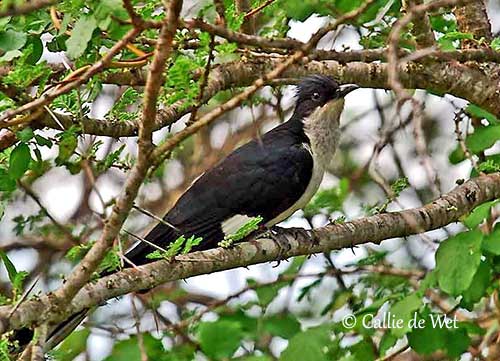
BEHAVIOUR IN THE WILD:
The Jacobin Cuckoo feeds mainly on hairy caterpillars, but it also takes various insects such as mantids, grasshoppers and termites. In addition, it feeds on some snails and berries. The female eats the eggs of the host species before laying its own eggs.
It is usually active in low shrubby acacia areas, feeding mainly in trees and bushes, snatching insects from foliage. But it may come to the ground and hops while searching for food. But it is chiefly arboreal.
The Jacobin Cuckoo is generally seen alone or in pairs. Rather restless, it spends much of its time flying in pairs.
The Jacobin Cuckoo is a brood-parasitic species, and several bird species become the foster parents of its chicks. There are mainly babblers (Turdoides) in India and sub-Saharan Africa, whereas in South Africa, the hosts are mostly bulbuls and shrikes.
Sometimes, two birds can be seen chasing one another in flight, probably as courtship display before mating.
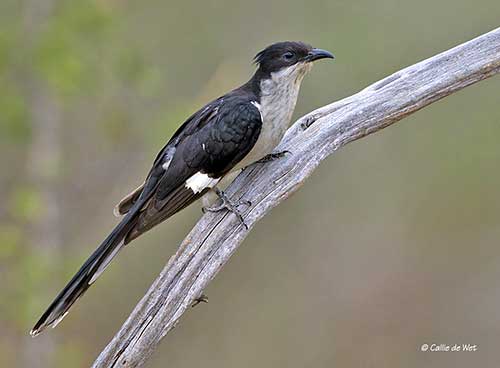
The Jacobin Cuckoo is an intra-African migrant with complex movements across its range, and between India and Africa. The arrival on the breeding grounds is related to rains and caterpillar abundance. It reaches more equatorial woodlands during the dry season.
In India, the species is also associated with rains, and usually leaves early in the dry season. The nominate race C.j. jacobinus from India winters in E and C Africa. The race C.j. pica is rare in winter in Asia but it migrates to Africa.
The Jacobin Cuckoo has swift, straight, low flight.
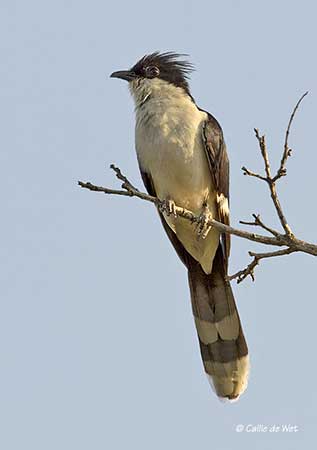
REPRODUCTION OF THIS SPECIES:
The breeding season takes place during the rains and varies according to the range.
The Jacobin Cuckoo usually lays 25 eggs per season in different nests. The female lays one egg per nest, rarely two. There are sometimes more cuckoo’s eggs, but they are the result of the laying of several females in the same nest. The eggs are glossy white in South Africa, and mostly greenish-blue in India, Sri Lanka and some regions of Africa.
Eviction of eggs or chicks of the host by the young cuckoo is weakly developed in this species, and may occur within the first 24 hours after hatching. But usually, the chick’s host is trodden into the bottom of the nest and dies by starving. It is removed by the parents and the young cuckoo is tended by both foster parents.
The incubation lasts 10-11 days. The young fledges 17-18 days after hatching. It is fully independent one month later.
PROTECTION / THREATS / STATUS:
The Jacobin Cuckoo is generally common throughout much of the wide range. The population is suspected to be stable and not globally threatened.
The Jacobin Cuckoo is currently evaluated as Least Concern.
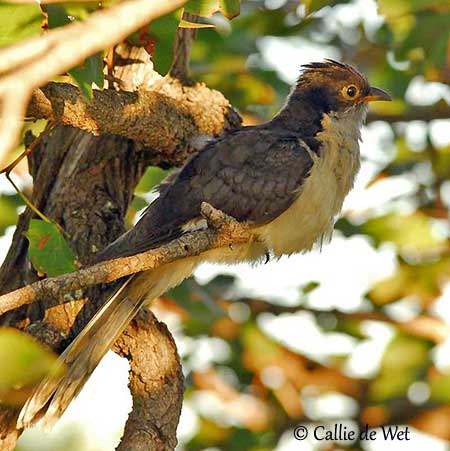
C.j. serratus
Juvenile